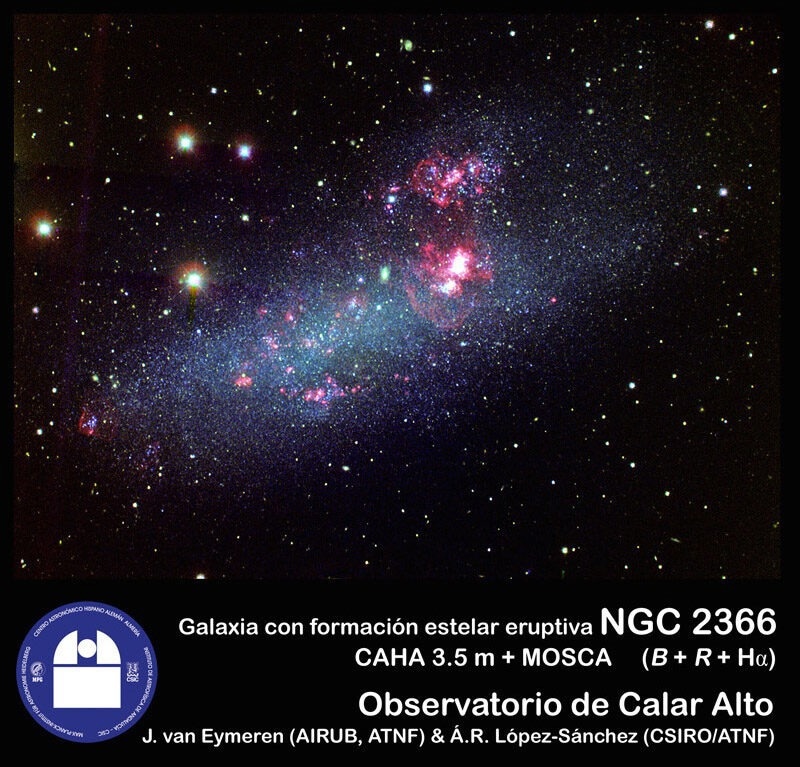The enormous galaxies crowded with stars can be assumed to be star factories, whirling out brilliant balls of gas. In reality, fewer developed dwarf galaxies have larger regions of star factories with higher rates of star formation.
 University of Michigan astronomer Sally Oey studied a star-forming region in the host galaxy, NGC 2366, which is a typical dwarf irregular galaxy. Image Credit: Observatorio de Calar Alto, J. van Eymeren (AIRUB, ATNF) & A.R. Lopez-Sanchez.
University of Michigan astronomer Sally Oey studied a star-forming region in the host galaxy, NGC 2366, which is a typical dwarf irregular galaxy. Image Credit: Observatorio de Calar Alto, J. van Eymeren (AIRUB, ATNF) & A.R. Lopez-Sanchez.
The University of Michigan researchers have unraveled the cause behind this phenomenon: these galaxies experience a unique 10-million-year delay before expelling the gas that congests their surroundings. This delay enables the retention of gas and dust within the star-forming regions, facilitating the coalescence and evolution of more stars.
In relatively pristine dwarf galaxies, massive stars with a mass range of about 20 to 200 times that of the sun tend to collapse into black holes instead of undergoing supernova explosions.
In contrast, in more evolved and polluted galaxies such as the Milky Way, these massive stars are more likely to explode, creating a collective superwind. This superwind results in the expulsion of gas and dust from the galaxy, causing star formation to rapidly cease.
The research is published in the Astrophysical Journal.
As stars go supernova, they pollute their environment by producing and releasing metals. We argue that at low metallicity-galaxy environments that are relatively unpolluted-there is a 10-million-year delay in the start of strong superwinds, which, in turn, results in higher star formation.
Michelle Jecmen, Study First Author and Undergraduate Researcher, University of Michigan
The researchers at U-M reference the Hubble tuning fork, a diagram pioneered by astronomer Edwin Hubble to categorize galaxies. Within this model, the handle of the tuning fork represents the largest galaxies—massive, spherical entities teeming with stars that have exhausted their gas reservoirs to form stars.
Extending along the tines of the tuning fork are spiral galaxies exhibiting gas and compact star-forming regions within their spiral arms. Finally, at the tip of the tuning fork's tines reside the least developed, smallest galaxies in the classification.
But these dwarf galaxies have just these really mondo star-forming regions. There have been some ideas around why that is, but Michelle’s finding offers a very nice explanation: These galaxies have trouble stopping their star formation because they don’t blow away their gas.
Sally Oey, Senior Author and Astronomer, University of Michigan
Moreover, this 10-million-year span of tranquility provides astronomers with a window to observe situations akin to the cosmic dawn—an era immediately following the Big Bang, as described by Jecmen. Within pristine dwarf galaxies, gas clusters create voids through which radiation can disperse.
This known occurrence aligns with the "picket fence" model, illustrating UV radiation escaping through gaps akin to slats in a fence. The delay elucidates how gas could have had the opportunity to aggregate into these formations.
Ultraviolet radiation holds significance as it ionizes hydrogen, mirroring a process that occurred just after the Big Bang, leading the universe's transition from opacity to transparency.
And so looking at low-metallicity dwarf galaxies with lots of UV radiation is somewhat similar to looking all the way back to the cosmic dawn. Understanding the time near the Big Bang is so interesting. It’s foundational to our knowledge. It’s something that happened so long ago - it’s so fascinating that we can see sort of similar situations in galaxies that exist today.
Michelle Jecmen, Study First Author and Undergraduate Researcher, University of Michigan
Oey’s research, published in the Astrophysical Journal Letters uses the Hubble Space Telescope to look at Mrk 71, a region in a nearby dwarf galaxy about 10 million light years away. In Mrk 71, observational evidence of Jecmen’s scenario is found by the group. The group employs a filter set that focuses on the light of triply ionized carbon utilizing a novel method of the Hubble Space Telescope.
Within highly developed galaxies abundant in supernova explosions, these events elevate the temperature of gas within a star cluster to extremely high levels—reaching millions of degrees Kelvin, according to Oey.
Consequently, as this intense superwind expands, it forcefully expels the remaining gas from the star clusters. However, in environments with low metallicity like Mrk 71, where stellar explosions are scarce, the energy within the area dissipates through radiation. Consequently, it lacks the opportunity to generate a superwind.
The team’s filters demonstrate that the energy is radiating away by choosing a diffuse glow of the ionized carbon throughout Mrk 71. Thus, allowing dense gas to be present throughout the environment without hot superwind.
Oey and Jecmen highlight numerous implications stemming from their research.
Oey concludes, “Our findings may also be important in explaining the properties of galaxies that are being seen at cosmic dawn by the James Webb Space Telescope right now. I think we’re still in the process of understanding the consequences.”
Journal References:
Jecmen, M. C., & Oey, M. S. (2023) Delayed Massive-star Mechanical Feedback at Low Metallicity. Astrophysical Journal. doi.org.10.3847/1538-4357/ad0460.
Oey, M. S. et al. (2023) Nebular C ivλ1550 Imaging of the Metal-poor Starburst Mrk 71: Direct Evidence of Catastrophic Cooling. Astrophysical Journal Letters. doi.org/10.3847/2041-8213/ad07dd.